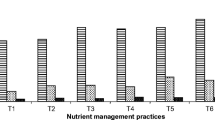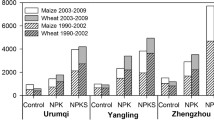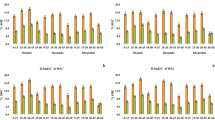Abstract
Long-term storage of soil organic carbon (SOC) is essential for sustainability of agricultural ecosystems and maintaining overall environment quality as soils contain a significant part of global carbon stocks. In this study, we attempted to explain the carbon mineralization and temperature sensitivity of SOC in maize–wheat systems, a common cropping system in the semi-arid regions of India. Soil samples(0–0.15 m) from long-term experimental plots laid in split plot design with two tillage systems (conventional tillage and bed planting) and six nutrient management treatments (T 1 = control, T 2 = 120 kg urea—N/ha, T 3 = T2 (25 % N substituted by farmyard manure (FYM)), T 4 = T 2 (25 % N substituted by sewage sludge), T 5 = T 2 + crop residue, T 6 = 100 % recommended doses of N through organic source - 50 % FYM + 25 % biofertilizer + 25 % crop residue) were incubated at different temperatures (25, 30, 35, and 40 °C) to determine the thermal sensitivity parameters associated with carbon mineralization. Earlier reports suggest a selective preservation of C3-derived carbon fractions over C4 in the SOC pool, and this is the first instance where δ 13C signatures (C4-derived carbon) were used as a qualitative measure to assess thermal sensitivity of SOC pools in the maize—wheat crop rotation systems of semi-arid India. Among the nutrient management treatments, mineral fertilizers were found to add more C4-derived carbon to the SOC pool in both the tillage systems but shows less promise in SOC stability as indicated by their lower activation energies (Ea) (14.25 kJ mol−1). Conventional tillage was found to mineralize 18.80 % (T 1—control at 25 °C) to 29.93 % carbon (T 3—mineral fertilizer + FYM at 40 °C) during the 150 days of incubation which was significantly higher than bed planting system (14.90 % in T 1—control at 25 °C and 21.99 % in T 6—100% organic sources at 40 °C). Organic manures, especially FYM (19.11 kJ mol−1) and 100 % organics (19.33 kJ mol−1) were more effective in enhancing the Ea of SOC than plots with mineral fertilizers alone (14.25 kJ mol−1), but had relatively higher Q 10 values thereby corroborating the thermal sensitivity hypothesis of recalcitrant organic compounds in soil. Michaelis–Menten derivatives along with thermal sensitivity indicators such as Ea and Q 10 were found to be efficient parameters for explaining carbon mineralization and CO2 efflux from soils.




Similar content being viewed by others
References
Allison, S. D., Wallenstein, M. D., & Bradford, M. A. (2010). Soil carbon response to warming dependent on microbial physiology. Nature Geoscience, 3(5), 336340.
Anderson, J. P. E. (1982). Soil respiration. In A. L. Page, R. H. Miller, & D. R. Keeney (Eds.), Methods of soil analysis, part 2. Chemical and Microbiological properties (pp. 831–871). Madison: Agronomy monograph No. 9, ASA - SSSA publisher.
Balesdent, J., & Mariotti, A. (1996). Measurement of soil organic matter turnover using 13C natural abundance. In T. W. Boutton & S. Yamasaki (Eds.), Mass Spectrometry of Soils (pp. 83–111). New York: Marcel Dekker.
Biasi, C., Pitkamaki, A. S., Tavi, N. M., Koponen, H. T., & Martikainen, P. J. (2012). An isotope approach based on 13C pulse-chase labelling vs. the root trenching method to separate heterotrophic and autotrophic respiration in cultivated peatlands. Boreal Environment Research, 17, 184–192.
Bird, M. I., & Pousai, P. (1997). Variations of δ13C in the surface soil organic carbon pool. Global Biogeochemical Cycles, 11, 313–322.
Boddy, E., Roberts, P., Hill, P. W., Farrar, J., & Jones, D. L. (2008). Turnover of low molecular weight dissolved organic C (DOC) and microbial C exhibit different temperature sensitivities in Arctic tundra soils. Soil Biology and Biochemistry, 40, 1557–1566.
Bradford, M. A., Davies, C. A., Frey, S. D., Maddox, T. R., Melillo, J. M., Mohan, J. E., Reynolds, J. F., Treseder, K. K., & Wallenstein, M. D. (2008). Thermal adaptation of soil microbial respiration to elevated temperature. Ecology Letters, 11, 1316–1327.
Brown, R. H. (1978). A difference in N use efficiency in C3 and C4 plants and its implication in adaptation and evaluation. Crop Science, 18, 93–98.
Cernusak, L. A., Tcherkez, G., Keitel, C., Cornwell, W. K., Santiago, L. S., Knohl, A., Barbour, M. M., Williams, D. G., Reich, P. B., Ellsworth, D. S., Dawson, T. E., Griffiths, H. G., Farquhar, G. D., & Wright, I. J. (2009). Why are non-photosynthetic tissues generally 13C-enriched compared with leaves in C3 plants? Review and synthesis of current hypotheses. Functional Plant Biology, 36, 199–213.
Cogle, A. L., Saffigna, P. G., & Strong, W. M. (1989). Carbon transformation during wheat straw decomposition. Soil Biology and Biochemistry, 21, 367–372.
Conant, R. T., Ryan, M. G., Ågren, G. I., Birge, H. E., Davidson, E. A., Eliasson, P. E., Evans, S. E., Frey, S. D., Giardina, C. P., Hopkins, F., Hyvönen, R., Kirschbaum, M. U. F., Lavallee, J. M., Leifeld, J., Parton, W. J., Steinweg, J. M., Wallenstein, M. D., Wetterstedt, J. Å. M., & Bradford, M. A. (2011). Temperature and soil organic matter decomposition rates—synthesis of current knowledge and a way forward. Global Change Biology, 17, 3392–3404.
Craine, J. M., Fierer, N., & Mclauchlan, K. K. (2010). Widespread coupling between the rate and temperature sensitivity of organic matter decay. Nature Geoscience, 3, 854–857.
Daniel, J., Davis, J., & Grant, L. (2002). Organic Farming Research Foundation Project Report, #00–49: long-term organic farming impacts on soil fertility.
Davidson, E. A., Janssens, I. A., & Luo, Y. (2006). On the variability of respiration in terrestrial ecosystems: moving beyond Q10. Global Change Biology, 12, 154–164.
Ehleringer, J. R., & Osmond, C. B. (1989). Stable isotopes. In R. W. Pearcy, J. Ehlringer, H. A. Mooney, & P. W. Rundel (Eds.), Plant Physiological Ecology: Field Methods and Instrumentation (pp. 281–300). Chapman and Hall: New York.
Fang, C., Smith, P., Moncrieff, J. B., & Smith, J. U. (2005). Similar response of labile and resistant soil organic matter pools to changes in temperature. Nature, 433, 57–59.
Fry, B. (2006). Stable isotope ecology. Berlin: Springer-Verlag.
Giardina, C. P., & Ryan, M. G. (2000). Evidence that decomposition rates of organic carbon in mineral soil do not vary with temperature. Nature, 404, 858–861.
Gillabel, J., Cerbrian-Lopez, B., Six, J., & Merckx, R. (2010). Experimental evidence for the attenuating effect of SOM protection on temperature sensitivity of SOM decomposition. Global Change Biology, 16, 2789–2798.
Hobbs, J. K., Jiao, W., Easter, A. D., Parker, E. J., Schipper, L. A., & Arcus, V. L. (2013). Change in heat capacity for enzyme catalysis determines temperature dependence of enzyme catalyzed rates. ACS Chemical Biology, 8, 2388–2393.
Houghton, R. A. (2007). Balancing the global carbon budget. The Annual Review of Earth and Planetary Sciences, 35, 313–347.
Karlén, I., Olsson, I. U., Kallburg, P., & Kilici, S. (1968). Absolute determination of the activity of two 14C dating standards. Arkiv Geofysik, 4, 465–471.
Katyal, J. C., Rao, N. H., & Reddy, M. N. (2001). Critical aspects of organic matter management in the tropics: the example of India. Nutrient Cycling in Agroecosystems, 61, 77–88.
Kirschbaum, M. U. F. (1995). The temperature dependence of soil organic matter decomposition, and the effect of global warming on soil organic C storage. Soil Biology and Biochemistry, 27, 753–760.
Knorr, W., Prentice, I. C., House, J. I., & Holland, E. A. (2005). Long-term sensitivity of soil carbon turnover to warming. Nature, 433, 298–301.
Kuzyakov, Y., & Domanski, G. (2000). Carbon input by plants into soil—review. Journal of Plant Nutrition and Soil Science, 163, 421–431.
Lal, R., Kimble, J. M., Follet, R. F., & Cole, C. V. (1998). Potential of U.S. cropland to sequester C and mitigate the greenhouse effect. Boca Raton: CRC/Lewis.
Leite, L. F. C., Mendonca, E. S., Machado, P. L. O. A., & Matos, E. S. (2003). Total C and N storage and organic C pools of a red yellow podzolic under conventional and no tillage at the Atlantic forest zone, south eastern Brazil. Australian Journal of Soil Research, 41, 717–730.
Lloyd, J., & Taylor, J. A. (1994). On the temperature dependence of soil respiration. Functional Ecology, 8(3), 315–323.
Luo, Y. Q., Wan, S. Q., Hui, D. F., & Wallace, L. L. (2001). Acclimatization of soil respiration to warming in a tall grass prairie. Nature, 413, 622–625.
Lu, C., Ma, J., Chen, X., Zhang, X., Shi, Y., & Huang, B. (2010). Effect of nitrogen fertilizer and maize straw incorporation on NH4 +-15N and NO3 −-15N accumulation in black soil of northeast China among three consecutive cropping cycles. Journal of Soil Science and Plant Nutrition, 10, 443–453.
Majumder, B., Mandal, B., & Bandyopadhyay, P. K. (2008). Soil organic carbon pools and productivity in relation to nutrient management in a 20-year-old rice berseem agroecosystem. Biology and Fertility of Soils, 44, 451–461.
Medina, E. (1970). Effect of nitrogen supply and light intensity during growth on the photosynthetic capacity and carboxydismutase activity of leaves of Atriplex patula spp. hastata. Carnegie Institute Year Book, 70, 551–559.
Paustian, K., Cole, C. V., Sauerbeck, D. R., & Sampson, N. (1998). CO2 mitigation by agriculture: an overview. Climatic Change, 40, 135–162.
Plante, A. F., Carlson, J., Greenwood, R., Shulmanb, J. M., Haddix, M. L., & Paul, E. A. (2010). Decomposition temperature sensitivity of particulate and non-hydrolyzable soil organic matter. Soil Biology and Biochemistry, 42, 1991–1996.
Reichstein, M., Kätterer, T., Andre, O., Ciais, P., Schulze, E. D., Cramer, W., Papale, D., & Valentini, R. (2005). Does the temperature sensitivity of decomposition vary with soil organic matter quality? Biogeoscience Discussions, 2, 737–747.
Ryan, M. C., Aravena, R., & Gillham, R. W. (1995). The use of 13C natural abundance to investigate the turnover of the microbial biomass and active fractions of soil organic matter under two tillage treatments. In R. Lal, J. Kimble, E. Levine, & B. A. Stewart (Eds.), Soils and Global Change (pp. 351–360). Boca Raton: CRC Press.
Sandeep, S., & Manjaiah, K. M. (2014). Thermal stability of organic carbon in soil aggregates of maize-wheat system in semi arid India. Journal of Soil Science and Plant Nutrition, 14, 625–639.
Sandeep, S., Manjaiah, K. M., Pal, S., & Singh, A. K. (2016). Soil carbon fractions under maize–wheat systems: effect of tillage and nutrient management. Environmental Monitoring and Assessment, 188, 14. doi:10.1007/s10661-015-4995-3.
Schipper, L. A., Hobbs, J. K., Rutledge, S., & Arcus, V. L. (2014). Thermodynamic theory explains the temperature optima of soil microbial processes and high Q10 values at low temperatures. Global change biology, 20, 3578–3586.
Seemann, J. R., Sharkey, T. D., Wang, J., & Osmond, C. B. (1987). Environmental effects on photosynthesis, nitrogen-use efficiency, and metabolite pools in leaves of sun and shade plants. Plant Physiology, 84(3), 796–802.
Shirani, H., Hajabbasi, M. A., Afyuni, M., & Hemmat, A. (2002). Effects of farmyard manure and tillage systems on soil physical properties and corn yield in central Iran. Soil and Tillage Research, 68, 101–108.
Sihi, D., Gerber, S., Inglett, P. W., & Inglett, K. S. (2016). Comparing models of microbial substrate interactions and their response to warming. Biogeosciences, 13, 1733–1752.
Singh, G. R., Pandya, K. S., Chaure, N. K., Parihar, S. S., & Choudhary, K. (2000). Soil fertility, productivity and profitability of rice under different organic manures. Oryza, 37, 208–212.
Six, J., Bossuyt, H., Degryze, S., & Denef, K. (2004). A history of research on the link between (micro) aggregates, soil biota, and soil organic matter dynamics. Soil and Tillage Research, 79, 7–31.
Six, J., Conant, R. T., Paul, E. A., & Paustian, K. (2002). Stabilization mechanisms of soil organic matter: implications for C-saturation of soils. Plant and Soil, 241, 155–176.
Still, C. J., Berry, J. A., Collatz, J. G., & DeFries, R. S. (2003). Global distribution of C3 and C4 vegetation: carbon cycle implications. Global Biogeochemical Cycles, 17, 1–6.
Tian, G., Kang, B. T., & Brussaard, T. (1992). Biological effects of plant residues with contrasting chemical compositions under humid tropical conditions: decomposition and nutrient release. Soil Biology and Biochemistry, 24, 1051–1060.
Tjoelker, M. G., Oleksyn, J., & Reich, P. B. (2001). Modelling respiration of vegetation: evidence for a temperature-dependent Q10. Global Change Biology, 7, 223–230.
Trinsoutrot, I., Recous, S., Mary, B., & Nicholardot, B. (2000). C and N fluxes of decomposing 13C and 15N Brassica napus L: effects of residue composition and N content. Soil Biology and Biochemistry, 32, 1717–1730.
Vanhala, P., Karhu, K., Tuomi, M., Sonninenb, E., Jungnerb, H., Fritzec, H., & Liskia, J. (2007). Old soil carbon is more temperature sensitive than the young in an agricultural field. Soil Biology and Biochemistry, 39, 2967–2970.
Verma, B. C., Datta, S. P., Rattan, R. K., & Singh, A. K. (2010). Monitoring changes in soil organic carbon pools, nitrogen, phosphorus, and sulfur under different agricultural management practices in the tropics. Environmental Monitoring and Assessment, 171, 579–593.
Von Lützow, M., & Kögel-Knabner, I. (2009). Temperature sensitivity of soil organic matter decomposition—what do we know? Biology and Fertility of Soils, 46, 1–15.
Von Lützow, M., Kögel-Knabner, I., Ekschmitt, K., Matzner, E., Guggenberger, G., Marschner, B., & Flessa, H. (2006). Stabilization of organic matter in temperate soils: mechanisms and their relevance under different soil conditions—a review. European Journal of Soil Science, 57, 426–445.
Walkley, A., & Black, I. A. (1934). An examination of the Degtjareff method for determining soil organic matter and a proposed modification of the chromic acid titration method. Soil Science, 37, 29–38.
Wallenstein, M., Allison, S. D., Ernakovich, J., Steinweg, J. M., & Sinsabaugh, R. L. (2011). Controls on the temperature sensitivity of soil enzymes: a key driver of in situ enzyme activity rates. In G. Shukla & A. Varma (Eds.), Soil enzymology (pp. 245–258). Berlin: Springer.
Wang, W. J., Baldock, J. A., Dalal, R. C., & Moody, P. W. (2004). Decomposition dynamics of plant materials in relation to nitrogen availability and biochemistry determined by NMR and wet-chemical analysis. Soil Biology and Biochemistry, 36, 2045–2058.
Wieder, W. R., Bonan, G. B., & Allison, S. D. (2013). Global soil carbon projections are improved by modelling microbial processes. Nature Climate Change, 3, 909–912.
Wynn, J. G., & Bird, M. (2007). C4-derived soil organic carbon decomposes faster than its C3 counterpart in mixed C3/C4 soils. Global Change Biology, 13, 1–12.
Author information
Authors and Affiliations
Corresponding author
Rights and permissions
About this article
Cite this article
Sandeep, S., Manjaiah, K.M., Mayadevi, M.R. et al. Monitoring temperature sensitivity of soil organic carbon decomposition under maize–wheat cropping systems in semi-arid India. Environ Monit Assess 188, 451 (2016). https://doi.org/10.1007/s10661-016-5455-4
Received:
Accepted:
Published:
DOI: https://doi.org/10.1007/s10661-016-5455-4




